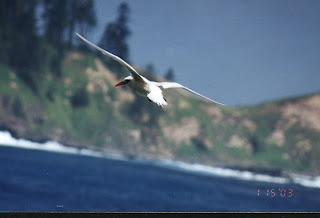As predicted when the young boobies were hatching, the frigatebirds are now a regular feature over our breeding colonies at the north end of the island and on the rocky offshore stacks.
Easily identified by their bent wings and forked tail, the differentiation between Greater and Lesser is made by the size (not always easy to discern as they fly at height) and the extent of the white markings on the breast.
In years gone by these birds were remarked upon as they were only seen after storms had passed through, but there seems to now be a resident population. They are seen at many times of the year, and may be breeding on the offshore stacks and at the inaccessible southern part of Phillip Island. They are far more obvious and numerous when the boobies are breeding.
 We see up to 8 at a time, slowly soaring across the clifftops where the young boobies wait for their food to be delivered, and a similar number has been reported perched in trees near the colony offshore from (Captain) Cook's monument. As most will know, the frigatebirds are robbers and will harass any bird carrying food back to its young, until the food is dropped or regurgitated and the frigatebirds will swoop down and catch it before it hits the water.
We see up to 8 at a time, slowly soaring across the clifftops where the young boobies wait for their food to be delivered, and a similar number has been reported perched in trees near the colony offshore from (Captain) Cook's monument. As most will know, the frigatebirds are robbers and will harass any bird carrying food back to its young, until the food is dropped or regurgitated and the frigatebirds will swoop down and catch it before it hits the water.Although we have seen both greater and lesser in the area in the past, we have so far seen only the Greater frigatebirds this year.
An interesting note about their scientific names : when they were first described it was thought that these birds were part of the pelican family, so the Greater frigatebird was named Fregata minor (being smaller than pelicans) and the Lesser frigatebird is Fregata ariel.Thanks to Andrew Marshall who provided these images.

















.jpg)
.jpg)
+Oost.jpg)

tr.jpg)




